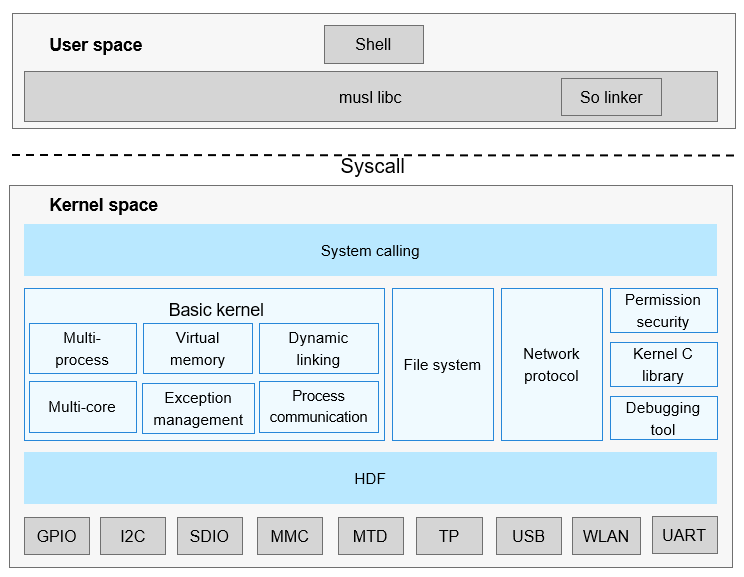新增link/symlink/readlink接口的系统调用及内核实现,当前仅支持jffs2文件系统。具体接口说明如下: 一、hard link 接口原型: int link(const char *oldpath, const char *newpath); int linkat(int olddirfd, const char *oldpath, int newdirfd, const char *newpath, int flags); 作用: 创建oldpath的硬链接,名为newpath。 功能说明: 1、newpath与oldpath必须在同一挂载分区内。 2、若newpath已存在,不会覆盖,错误码EEXIST。 3、oldpath必须为普通文件或者软链接文件。 4、如果oldpath是一个软链接文件,那么: 若调用link接口或者linkat(flags=0),创建出软链接文件的硬链接; 若调用linkat(flags = AT_SYMLINK_FOLLOW),创建出软链接所指向源文件的硬链接。 5、oldpath与newpath对应同一个文件,对oldpath与newpath任一名字的操作都是直接操作文件,没有“原始文件”的说法。 6、使用cp命令拷贝一个硬链接文件,生成文件的拷贝,新文件的nlink数为1。 7、删除oldpath或newpath,底层文件仍存在,可以通过另一个path访问。只有当两个path都删除之后,才会真正将文件删除,空间释放。 二、symbol link 接口原型: int symlink(const char *target, const char *linkpath); int symlinkat(const char *target, int newdirfd, const char *linkpath); 作用: 创建一个软链接文件linkpath,存储字符串target。 功能说明: 1、target可以为任意字符串(长度小于PATH_MAX)。 2、若linkpath文件名已存在,不会覆盖,错误码EEXIST。 3、用readlink函数可读取软链接的target内容。 4、软链接文件本身大小为target长度。 5、ls时软链接文件类型显示为 'l'。 6、symlink最大循环次数为CONFIG_FS_MAX_LNK_CNT(目前为40),超出则返回错误,错误码ELOOP。 7、使用cp命令拷贝一个软链接文件: 若target是一个文件:创建一个源文件的拷贝,类型为普通文件; 若target非文件:拷贝失败。 三、readlink 接口原型: ssize_t readlink(const char *pathname, char *buf, size_t bufsiz); ssize_t readlinkat(int dirfd, const char *pathname, char *buf, size_t bufsiz); 作用: 读取软链接文件存放的的target内容。 功能说明: 1、pathname必须为软链接文件,否则错误码EINVAL。 2、如果bufsiz小于target长度,则截断target。 close #I3Q0OD Change-Id: I3864d6069b627b705a369e8e32dc1eb922dc0157 Signed-off-by: chenjing <chenjing139@huawei.com> |
||
|---|---|---|
| .gitee | ||
| apps | ||
| arch | ||
| bsd | ||
| compat/posix | ||
| drivers/char | ||
| figures | ||
| fs | ||
| kernel | ||
| lib | ||
| net | ||
| platform | ||
| security | ||
| shell | ||
| syscall | ||
| testsuites | ||
| tools | ||
| .gitignore | ||
| BUILD.gn | ||
| Kconfig | ||
| LICENSE | ||
| Makefile | ||
| README.md | ||
| README_zh-HK.md | ||
| README_zh.md | ||
| TODOList.md | ||
| build.sh | ||
| config.mk | ||
| kernel_test.sources | ||
README.md
LiteOS Cortex-A
Introduction
The OpenHarmony LiteOS Cortex-A is a new-generation kernel developed based on the Huawei LiteOS kernel. Huawei LiteOS is a lightweight operating system OS built for the Internet of Things IoT field. With the rapid development of the IoT industry, OpenHarmony LiteOS Cortex-A brings small-sized, low-power, and high-performance experience and builds a unified and open ecosystem for developers. In addition, it provides rich kernel mechanisms, more comprehensive Portable Operating System Interface POSIX, and a unified driver framework, Hardware Driver Foundation HDF, which offers unified access for device developers and friendly development experience for application developers. Figure 1 shows the architecture of the OpenHarmony LiteOS Cortex-A kernel.
Figure 1 Architecture of the OpenHarmony LiteOS Cortex-A kernel

Directory Structure
/kernel/liteos_a
├── apps # User-space init and shell application programs
├── arch # System architecture, such as ARM
│ └── arm # Code for ARM architecture
├── bsd # Code of the driver and adaptation layer module related to the FreeBSD, such as the USB module
├── compat # Kernel API compatibility
│ └── posix # POSIX APIs
├── drivers # Kernel drivers
│ └── char # Character device
│ ├── mem # Driver for accessing physical input/output (I/O) devices
│ ├── quickstart # APIs for quick start of the system
│ ├── random # Driver for random number generators
│ └── video # Framework of the framebuffer driver
├── fs # File system module, which mainly derives from the NuttX open-source project
│ ├── fat # FAT file system
│ ├── jffs2 # JFFS2 file system
│ ├── include # Header files exposed externally
│ ├── nfs # NFS file system
│ ├── proc # proc file system
│ ├── ramfs # RAMFS file system
│ └── vfs # VFS layer
├── kernel # Kernel modules including the process, memory, and IPC modules
│ ├── base # Basic kernel modules including the scheduling and memory modules
│ ├── common # Common components used by the kernel
│ ├── extended # Extended kernel modules including the dynamic loading, vDSO, and LiteIPC modules
│ ├── include # Header files exposed externally
│ └── user # Init process loading
├── lib # Kernel library
├── net # Network module, which mainly derives from the lwIP open-source project
├── platform # Code for supporting different systems on a chip (SOCs), such as Hi3516D V300
│ ├── hw # Logic code related to clocks and interrupts
│ ├── include # Header files exposed externally
│ └── uart # Logic code related to the serial port
├── platform # Code for supporting different systems on a chip (SOCs), such as Hi3516D V300
├── security # Code related to security features, including process permission management and virtual ID mapping management
├── syscall # System calling
└── tools # Building tools as well as related configuration and code
Constraints
- Programming languages: C and C++
- Applicable development boards: Hi3518E V300 and Hi3516D V300
- Hi3518E V300 uses the JFFS2 file system by default, and Hi3516D V300 uses the FAT file system by default.
Usage
OpenHarmony LiteOS Cortex-A supports the Hi3518E V300 and Hi3516D V300. You can develop and run your applications based on both development boards.
Preparations
You need to set up the compilation environment on Linux.
- For Hi3518E V300, see Setting Up the Hi3518 Development Environment.
- For Hi3516D V300, see Setting Up the Hi3516 Development Environment.
Source Code Acquisition
Download and decompress a set of source code on a Linux server to acquire the source code. For more acquisition methods, see Source Code Acquisition.
Compilation and Building
For details about how to develop the first application, see:
Repositories Involved
kernel_liteos_a